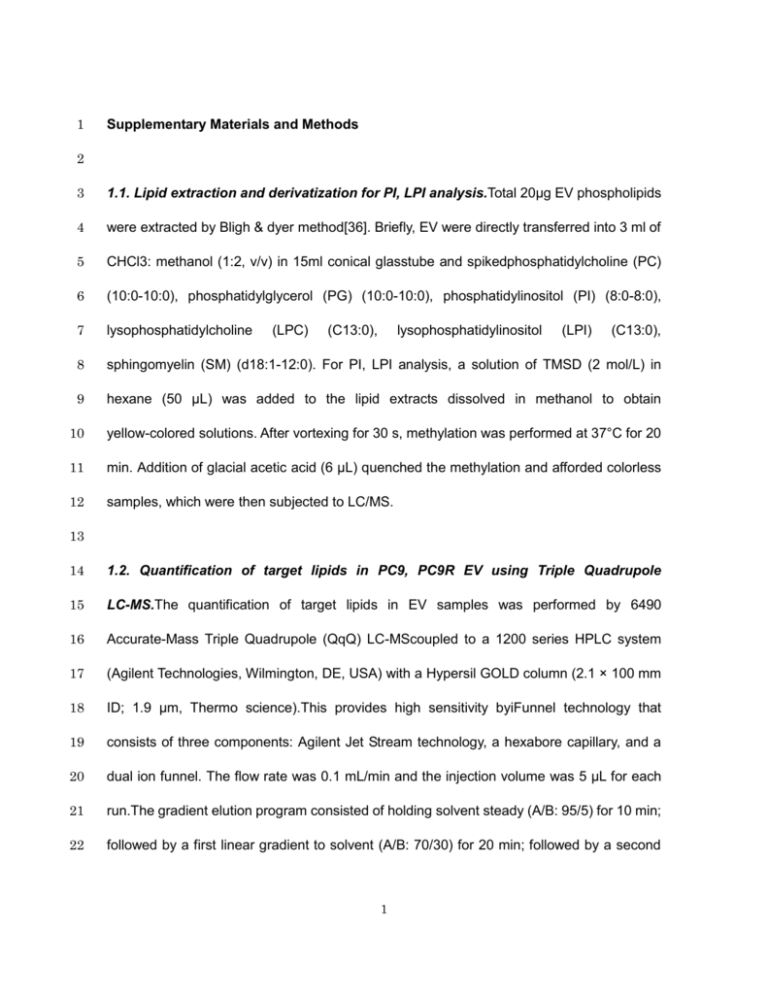pmic7978-sup-0005
advertisement

1 Supplementary Materials and Methods 2 3 1.1. Lipid extraction and derivatization for PI, LPI analysis.Total 20μg EV phospholipids 4 were extracted by Bligh & dyer method[36]. Briefly, EV were directly transferred into 3 ml of 5 CHCl3: methanol (1:2, v/v) in 15ml conical glasstube and spikedphosphatidylcholine (PC) 6 (10:0-10:0), phosphatidylglycerol (PG) (10:0-10:0), phosphatidylinositol (PI) (8:0-8:0), 7 lysophosphatidylcholine 8 sphingomyelin (SM) (d18:1-12:0). For PI, LPI analysis, a solution of TMSD (2 mol/L) in 9 hexane (50 µL) was added to the lipid extracts dissolved in methanol to obtain 10 yellow-colored solutions. After vortexing for 30 s, methylation was performed at 37°C for 20 11 min. Addition of glacial acetic acid (6 µL) quenched the methylation and afforded colorless 12 samples, which were then subjected to LC/MS. (LPC) (C13:0), lysophosphatidylinositol (LPI) (C13:0), 13 14 1.2. Quantification of target lipids in PC9, PC9R EV using Triple Quadrupole 15 LC-MS.The quantification of target lipids in EV samples was performed by 6490 16 Accurate-Mass Triple Quadrupole (QqQ) LC-MScoupled to a 1200 series HPLC system 17 (Agilent Technologies, Wilmington, DE, USA) with a Hypersil GOLD column (2.1 × 100 mm 18 ID; 1.9 μm, Thermo science).This provides high sensitivity byiFunnel technology that 19 consists of three components: Agilent Jet Stream technology, a hexabore capillary, and a 20 dual ion funnel. The flow rate was 0.1 mL/min and the injection volume was 5 μL for each 21 run.The gradient elution program consisted of holding solvent steady (A/B: 95/5) for 10 min; 22 followed by a first linear gradient to solvent (A/B: 70/30) for 20 min; followed by a second 1 23 linear gradient to solvent (A/B: 10/90) for 30 min; and terminating with isocratic elution at 24 solvent (A/B: 10/90) for 10 min. The column was equilibrated at 5% solvent B for 5 min 25 before reuse. Total run time was 65 min for each analysis. All acquisition methods used the 26 following parameters: 3500 V positive mode of capillary voltage, 3000 V negative mode of 27 capillary voltage, a sheath gas flow of 11 L/min (UHP nitrogen) at 200ºC, a drying gas flow 28 of 15 L/min at 150ºC, nebulizer gas flow at 25 psi. Multiple reaction monitoring (MRM) 29 conditions including transition and MS/MS collision energy were optimized to analyze target 30 lipids quite different in MALDI-TOF analysis. 31 32 1.3 Lipids quantification and data analysisBy using an ODS column, various lipid 33 species were separated according to their Cn and Un. For the compound with a higher Cn 34 and a lower Un, the RT increased. For data analysis, each peak mustbe selected on the 35 basis of a reasonable RT with high repeatability. Thus, we applied several internal 36 standards to identify various lipid species. 37 38 39 40 41 42 43 44 2 45 Supplementary Figure Legends 46 47 Supplementary Table 1.Optimized MRM conditions of target lipids were shown. 48 49 Figure S1. Comparison of MALDI-TOF MS spectra of phospholipids.Average positive ion 50 MALDI-TOF mass spectra of the lipid extracts of PC9R_cell (blue), PC9_cell (red), 51 PC9R_EV (green) and PC9_EV (yellow) was shown in bottom. The separated spectra of 52 each PC9R_cell, PC9_cell, PC9R_EV and PC9_EV were shown in top. 53 54 Figure S2. (A) A principal component analysis (PCA) plot for 30 PC9R_cell (blue), 30 55 PC9_cell (red), 30 PC9R_EV (blue sky) and 30 PC9_EV (green). (B) Hierarchical clustering 56 dendrograms of MS showing clustering patterns of PC9R_cell, PC9_cell, PC9R_EV and 57 PC9_EV. 58 59 Figure S3. (A) Heatmap of DRL obtained from positive ion mode with dendrogram, 60 representing the up- (in red) or down-regulated (in green) phospholipid spectra in PC9_EV 61 or PC9R_EV, compared to PC9R_EV or PC9_EV, respectively. (B) Heatmap of DRLs with 62 dendrogram obtained in negative ion mode. 63 64 Figure S4. Validation of identified DELs using MRM. The quantified peak areas were 65 normalized by the spiked internal standard for each lipid class. The height of the bar and 66 the error bar denote the average of the normalized peak area and the standard deviation of 67 triplicate measurements, respectively(*p <0.1, **p < 0.05, Student’s t-test). 68 69 3 70 Supplementary Table 1. MS/MS CE Lipids Ion mode MRM transitions (eV) PC Positive [M+H] > 184 26 PG Positive [M+NH4] > [M+NH4–189] 14 Methylated PI Positive [M+H] > [M+H–274] 14 LPC Positive [M+H] > 184 30 Methylated LPI Positive [M+H] > [M+H–274] 30 SM Positive [M+H] > 184 30 71 72 4








